
Dear INTOSAI WGEA Members and other readers,
It is my pleasure to greet you as the newly elected Auditor General of SAI Finland. I have over 20 years of experience in the public sector, and I am looking forward to continuing to work for sustainable use of public funds in this new role. As you well know, economic effects of climate change pose a formidable challenge for our economies, highlighting the importance of this Working Group.
In December, INTOSAI WGEA published the 10th environmental survey. It reveals, among other things, that adaptation to climate change will increasingly be in SAIs audit plans in the coming years. It is no surprise, as the impacts of the changing climate are inc…
Read More...Krinjal Mathur, U.S. GAO
During the past 25 years, Greenlines has provided a way for SAIs from around the world to share information and discuss a wide range of environmental auditing topics. In total, 64 countries have shared their work in Greenlines within the p…
Read More...
Read about your fellow auditors' work on environmental issues

Dear INTOSAI WGEA Members and other readers,
It is my pleasure to greet you as the newly elected Auditor General of SAI Finland. I have over 20 years of experience in the public sector, and I am looking forward to continuing to work for sustainable use of public funds in this new role. As you well know, economic effects of climate change pose a formidable challenge for our economies, highlighting the importance of this Working Group.
In December, INTOSAI WGEA published the 10th environmental survey. It reveals, among other things, that adaptation to climate change will increasingly be in SAIs audit plans in the coming years. It is no surprise, as the impacts of the changing climate are increasingly felt around the world. While more policies and funding instruments are directed to climate action, it is important that SAIs hold their governments accountable for their actions in this policy area.
I would like to thank Director Matti Okko for chairing the Working Group last year in addition to his other tasks as Acting Auditor General. As Mr. Okko announced in the 18th Steering Committee meeting in September 2021, SAI Finland is ready to chair the Working Group up to 2025, thus following the example of the previous chairs who also held the chairmanship for two Work Plan periods.
I am looking forward to the future activities of WGEA, which will be outlined in a new strategy and the Work Plan for 2023-2025. Year 2022 will be particularly exciting, as it is the 30th Anniversary of the Working Group. It is also the 25th Anniversary of Greenlines. We are very grateful to SAI USA for their efforts in keeping this Newsletter alive all these years. I hope you enjoy reading this edition!
Sami Yläoutinen
Auditor General, SAI Finland
Krinjal Mathur, U.S. GAO
During the past 25 years, Greenlines has provided a way for SAIs from around the world to share information and discuss a wide range of environmental auditing topics. In total, 64 countries have shared their work in Greenlines within the popular ‘News Briefs from around the SAI World’ feature. In that time, WGEA has held 17 WGEA Assembly Meetings, allowing representatives from member SAIs to come together to discuss important topics in the environmental auditing field. Since 1996, WGEA chairs have hailed from the Netherlands, Canada, Estonia, Indonesia, and Finland. This worldwide representation is further illustrated in the map below.
In addition to Greenlines’ geographic diversity, an extensive list of environmental topic areas have been covered in the newsletter. They include broad topics such as climate change, sustainable development, environmental degradation and damage, and wildlife protection that have been longstanding areas of discussion over the last 25 years. More specialized topics, such as natural resource accounting, was first mentioned in Greenlines’ initial issue published in December 1996 and has continued to be a topic for discussion in subsequent issues through the years. In past editions, member SAIs have also contributed discussions on other common topics, such as wetlands and water resources, agriculture, fisheries management, forestry, energy conservation, air pollution, and hazardous or radioactive waste.
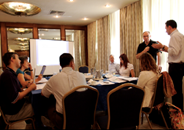 In addition to these popular topics, Greenlines issues have covered less frequently discussed environmental auditing topics, such as noise pollution, public hygiene, waste management, and GIS/data management, in articles from contributing member SAIs.
In addition to these popular topics, Greenlines issues have covered less frequently discussed environmental auditing topics, such as noise pollution, public hygiene, waste management, and GIS/data management, in articles from contributing member SAIs.


Partners from Brazil, Canada, Greece, Indonesia, Norway, South Africa, the United Kingdom, and the United States discuss adaptation issues in Athens, Greece (November 2010)
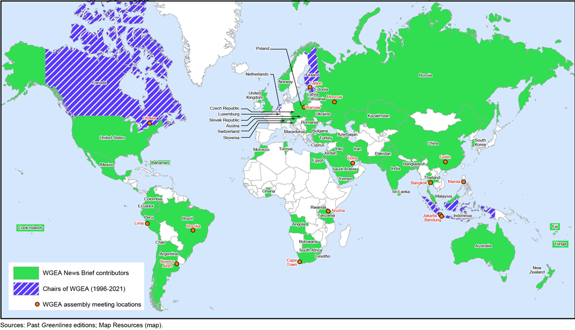
Greenlines’ history is filled with unique achievements and memories. Below is a summary of topics and events covered in past time periods of Greenlines.
1996 to 2000
The first issue of Greenlines was distributed in December 1996. This issue highlighted a working draft of a booklet on environmental auditing standards and guidelines, and another booklet for advice on the auditing of international environmental treaties through joint or coordinated audits. In addition, the issue provided other news updates, such as distributing an environmental auditing questionnaire to gather feedback from member SAIs and starting research on natural resource accounting, a topic that has persisted through the years and been discussed in more recent issues of Greenlines.
During its first five years, a total of 11 Greenlines issues were distributed to its member SAIs. These primarily focused on news and updates of WGEA, such as reminders and debriefs of WEGA Assembly Meetings, and served as a way for SAIs to share updates and request assistance from other WGEA members. But even in these early years, there were some major milestones. This included the creation of the WGEA website in January 1997, which was INTOSAI’s first working group/committee to establish a homepage. Also in 1997, WGEA produced a video entitled "the Miracle of Water" to support the importance of environmental auditing at the 4th WGEA Assembly Meeting in Estonia.
2001 to 2005
In the early 2000s, Greenlines continued its focus on updates and news from both INTOSAI and WGEA. This included information on agendas for meetings, SAI representative updates, and new WGEA products. Additionally, there was discussion of environmental audit papers and training courses. In fact, in October 2004 there was a fruitful partnership with INTOSAI development initiative to develop a training program on environmental auditing to foster information exchange, enhanced networking, and communication.
Around the same time, WGEA developed two papers that were adopted as formal INTOSAI guidance documents entitled “Sustainable Development: The Role of Supreme Audit Institutions” and “Environmental Auditing and Regularity Auditing.” In addition to these, some other environmental topic areas discussed during this period included water management, auditing waste management, and concurrent or joint audits.
Finally, in January 2005, Greenlines updated its format to include the features we see today. These consist of ‘Message from the Chair’, ‘Feature Story’, ‘WGEA News’, and ‘News Briefs around the SAI World’. This revision encouraged more of the member SAI’s to contribute to Greenlines and improved the newsletter’s accessibility as it could now be downloaded online in a document format.
2006 to 2010

This era of Greenlines started to highlight a wider breadth of environmental auditing topics, due to the revised format. For example, climate change was first mentioned in a ‘Feature Story’ in May 2007, which discussed the focus of climate change topics in environmental audits due to increased public interest. Greenlines also presented discussions on challenges faced in environmental auditing that revealed several common themes, such as the strong desire to build environmental auditing capacity and to work cooperatively with other SAIs to address problems of mutual interest.
Some new topics on agriculture, noise pollution, and fish resources management were also explored during this time. Not only were Greenlines articles spanning a variety of topic areas, but also geographic regions as ‘Feature Story’ contributors included countries such as Canada, Thailand, and Norway.
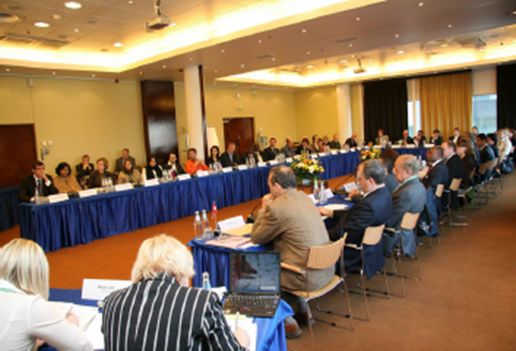
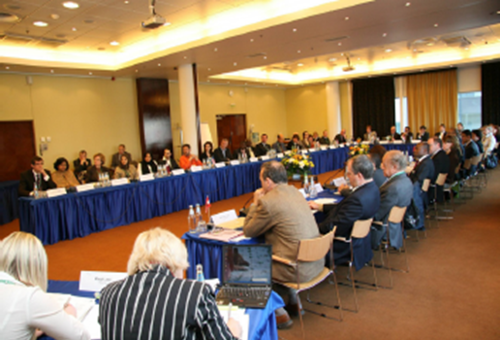
Representatives at the 7th WGEA Steering Committee Meeting met in Tallinn, Estonia
(June 2008)
2011 to 2015
This period had some unique ‘Feature Story’ articles that focused on training and international coordination. In June 2012, the WGEA Secretariat and several other WGEA Steering Committee members organized a one-day training seminar called “Environmental Auditing for Beginners” geared toward auditors with little experience in auditing environment-related matters.

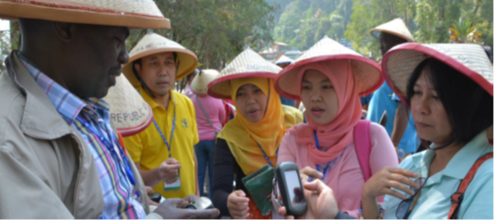
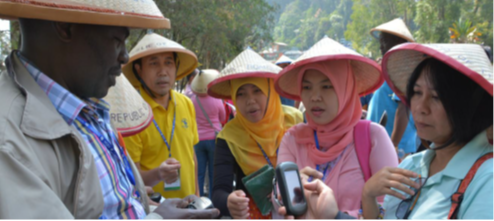
Participants of the 1st international training of forestry audits in Jakarta, Indonesia practicing using a GPS in a forest of Gede Pangrango National Park
(September 2014)
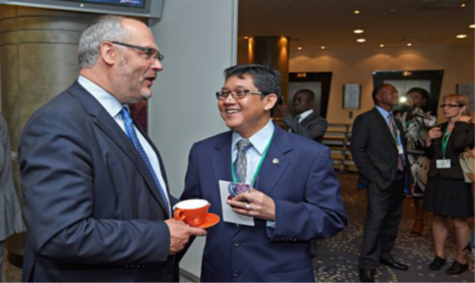
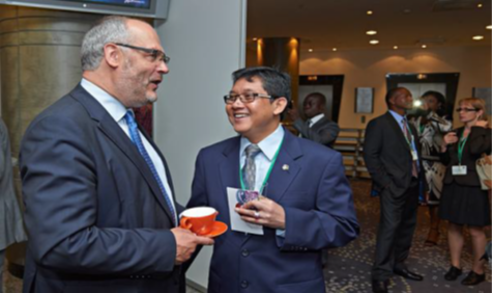
Dr Ali Masykur Musa, Member of the Audit Board of the Republic of Indonesia and Dr Alar Karis, Auditor General of Estonia, the Chairman of INTOSAI WGEA
(October 2013)
Additionally, in October 2013 there was discussion on SAIs having important roles in encouraging the world's governments to consider environmental sustainability in their use of natural resources, in addition to other activities. Furthermore, member SAIs contributed articles on a variety of environmental auditing topics such as greenhouse gas emissions, biodiversity, and energy conservation.
2016 to 2021
Over the last few years, Greenlines has continued to tackle similar environmental auditing topics, such as protected areas, sustainability, energy priorities, and environmental risk management. Also, during this time, Greenlines added the ‘WGEA Regional News’ as a regular feature in the newsletter and refreshed its layout in March 2018. This feature allowed for the dissemination of more specific regional news and update announcements to be shared widely to the WGEA community.

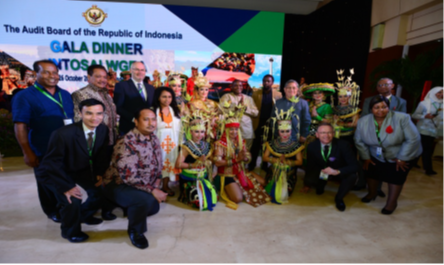

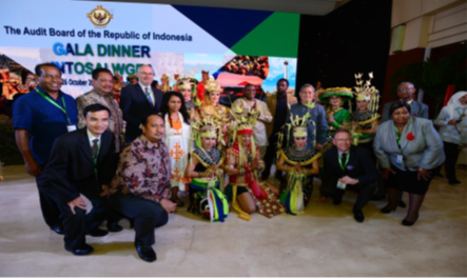
Participants of the 17th WGEA Assembly Meeting in Jakarta, Indonesia
(October 2016)
Most recently in January 2021, the 20th WGEA Assembly Meeting took place for the first time in a virtual, online format. During this meeting, it was also the first time the INTOSAI WGEA Awards were presented. The aim of the WGEA Awards is to promote sharing of environmental audit innovations and practices, and the 2021 awards were dedicated to visualizations used in environmental audits.
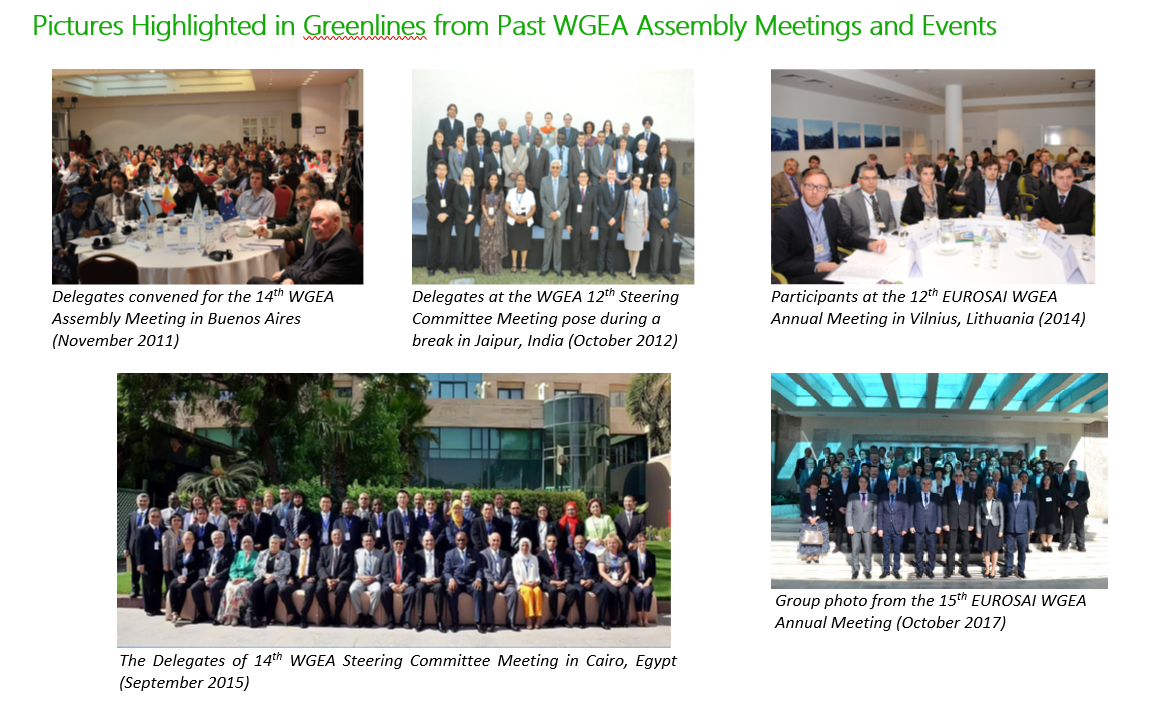
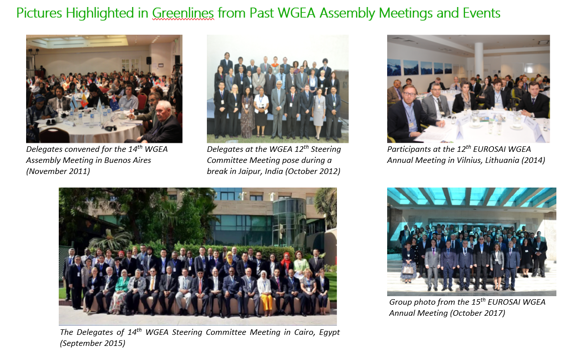

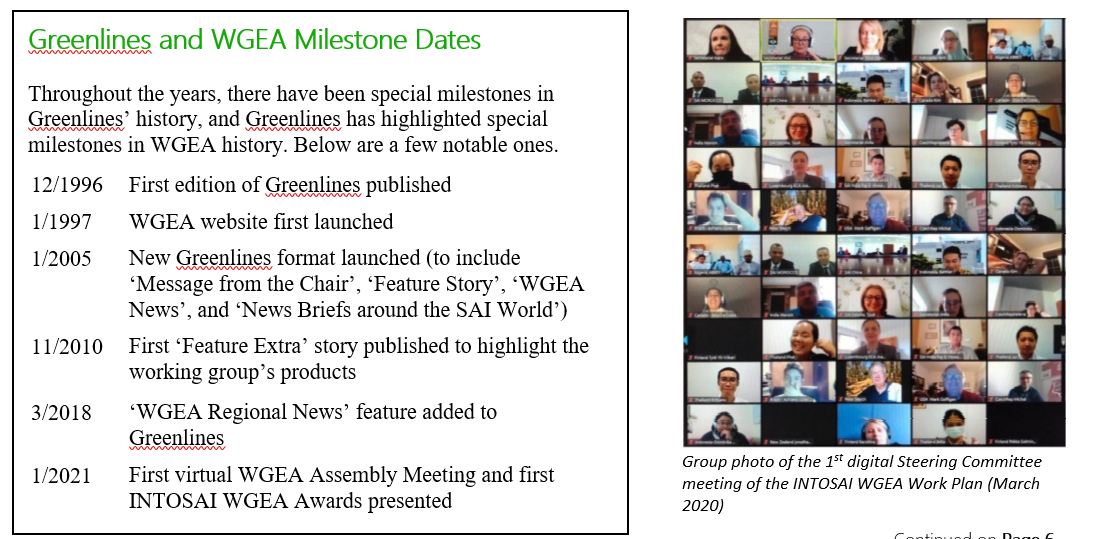
During the last half a year, the biggest endeavour for the Secretariat was organizing the 18th Steering Committee meeting on 20 – 24 September, once again as a series of online meetings. We kicked off the meeting with a future workshop feeding into the first WGEA strategy reaching up to 2030, and continued the strategy work in the last day, combined with ideas for the next Work Plan period 2023-2025. We are very excited about the highly relevant input we received and will continue the work, consulting the Steering Committee throughout the process.
One of the planned activities is to make better use of the audit database and provide compilations of SAIs’ audit activities. To have a topical view on SAIs’ activities, it is very important that all SAIs update their audits on a rolling basis to the database. You can get the access code from the Secretariat and find further instructions here: https://wgea.org/news-events/the-intosai-wgea-database-is-now-flexibly-available-for-audit-updates/.
The Steering Committee also provided their comments on seven Work Packages, which all have proceeded as planned. We can expect to have wonderful reports available in the Assembly meeting, to be scheduled for June 2022. The format of the meeting is still pending, but what is sure is that we will celebrate the 30th Anniversary of the WGEA! Year 2022 is a true super year not only for WGEA and Greenlines, but also for global sustainability (30 years from the Rio Earth Summit) and environmental policy (UNEP 50th Anniversary).
To acknowledge these occasions, we will plan a special programme in 2022. We already gained some experience on such activity by organising, with the support of the SAI USA, a webinar in the context of the COP26 climate conference. You can find the video recording of the webinar on our YouTube channel: INTOSAI WGEA COP26 Webinar: The role of auditors in the global climate challenge - YouTube. We also published the commentary note of the Director Youssef Nassef as an individual video: wgea cop26 - YouTube.
In October, the Secretariat co-organized with SAI Indonesia, a session on the SAI Contribution to Achieve Sustainable Transport and Promote Green Development at the Second United Nations Global Transport Conference. The meeting documents are available here: Side Events | Second Global Sustainable Transport Conference | United Nations.
The last publication of the year was the 10th INTOSAI WGEA Survey. The survey received responses from altogether 71 SAIs.
The survey and an infographic are available on our website: https://wgea.org/publications/surveys/.
There is also an animated version of the infographic: Environmental and climate audits on the rise – 10th INTOSAI WGEA survey (taiqa.com).
Stay tuned on the special programme for the 2022 by subscribing to our website updates https://wgea.org/ or following us on Twitter: @WGEASecre and LinkedIn.
Ministers of Environment and Energy of fifteen countries of the Economic Community of West African States (ECOWAS) have adopted, in February 2020 in Burkina Faso, regulations to introduce cleaner fuels and vehicles in the West African region.
From January 1, 2021, all fuels imported by ECOWAS countries will have to have a standard of 50 parts per million (ppm) sulphur for petrol and diesel. Currently, some countries in the region still have fuel standards that allow diesel fuels up to 10,000 ppm to be imported.
Local refineries have until January 1, 2025, to upgrade their operations to meet the new requirements and comply with other fuel parameters, including benzene and manganese. These new standards will improve air quality in the region.
In addition, all imported vehicles, both new and used, as well as petrol and diesel, will have to comply with a minimum EURO 4/IV vehicle emission standard from 1 January, 2021. It is a European standard which aims to standardise and reduce the pollutant emissions of vehicles. An age limit of 10 years for second-hand vehicles has also been agreed, with a recommended age limit of 5 years for light commercial vehicles. A plan to improve the fuel efficiency of imported vehicles was also adopted. The goal is to double the efficiency of the vehicle fleet from an average of eight litres per 100 kilometres today to 4.2 litres per 100 kilometres by 2030. An intermediate target of five litres per 100 kilometres by 2025 was also agreed by the ECOWAS authorities.
The roadmap on vehicle fuel efficiency also includes proposals to introduce fiscal incentives to attract low- or non-polluting vehicles to the region, measures to promote electric vehicles and a new harmonised label for newly imported vehicles indicating the vehicle’s fuel efficiency and carbon dioxide emissions.
Mr. Aghughu, Adolphus Arhotomhenla, JP, FCNA was appointed as the new Auditor-General and President of the AFROSAI-WGEA in February, 2021. Also, the First President of SAI Gabon is now Mr. René ABOGHE ELLA replacing Mr. Gilbert NGOULAI.
In 2016, at the AFROSAI-WGEA General Assembly in Abuja, members agreed to carry out a cooperative environmental audit of the Niger River. The AFROSAI-WGEA secretariat has successfully commenced the audit. The nine countries that make up the basin—Benin, Burkina Faso, Cameroon, Chad, Cote d'Ivoire, Guinea, Mali, Niger, and Nigeria—are partaking in the audit. A training session was held from 12 to 14 July, 2021, in preparation for the audit. Several virtual planning meetings have also been held, and the first physical meeting took place in Niamey, Niger, from 29 November to 3 December, 2021.
The Deutsche Gesellschaft für Internationale Zusammenarbeit (GIZ) is supporting the audit. An attempt to conduct a similar audit of the Nile River was put on hold due to some issues that are yet to be resolved.
The UN Biodiversity Lab (UNBL) 2.0 was launched this past October at the Nature for Life Hub. The UNBL 2.0 is a free, open-source platform that enables governments and others to access state-of-the-art maps and data on nature, climate change, and human development in new ways to generate insight for nature and sustainable development. It is freely available online to governments and other stakeholders as a digital public good.
Developed jointly by the United Nations Development Programme (UNDP), the United Nations Environment Programme World Conservation Monitoring Centre (UNEP-WCMC), and the Secretariat of the UN Biodiversity Convention, UNBL was first launched in 2018 to support governments in their commitments to the UN Biodiversity Convention, leading to a two-fold increase in the number of maps used in countries’ national reports on the state of biodiversity. UNBL 2.0 is now available in English, French, Portuguese, Russian and Spanish. The redesign offers modern web app design and enhanced functionalities based on user feedback, including more data, enhanced analytic capabilities, and analyses that support action at the national level.
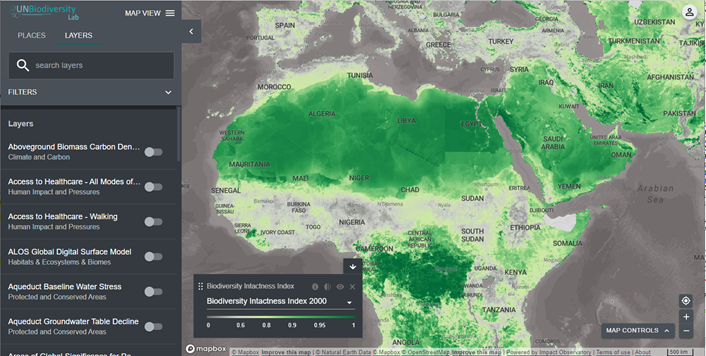
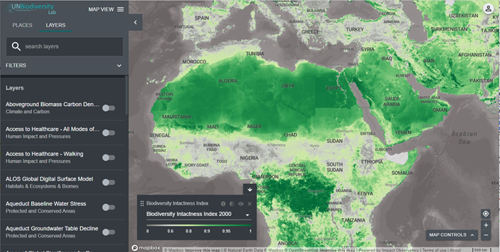
SAI Brazil (Federal Court of Accounts – TCU) has recently explored the use of UNBL in the context of environmental audits, with the support of the German cooperation through the Deutsche Gesellschaft für Internationale Zusammenarbeit (GIZ) GmbH, under the OLACEFS-GIZ Project ‘Strengthening of external financial control in the environmental field’. The project provided training on the use of the UNBL and developed guidance tailored to auditor needs. TCU now has access to a private secure UNBL workspace that can be used to support to its audits.
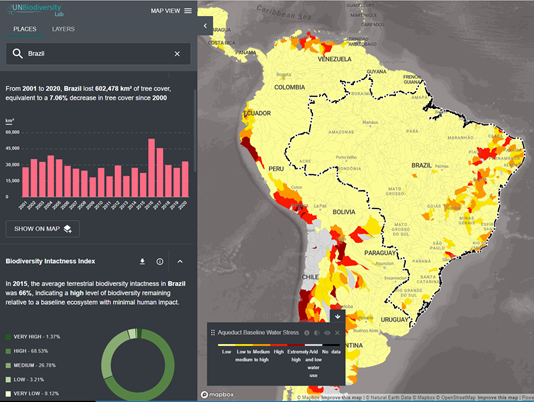
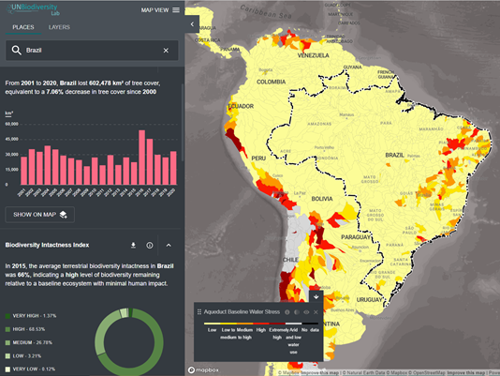
Environmental audits will often focus on topics with a spatial/geographical character (e.g., protected areas and forest law enforcement). In this context, access to reliable and relevant geospatial data is essential. Given UNBL provides governments access to environmental and sustainable development data, several data layers offered will likely align with auditing demands by SAIs. Besides, the possibility of creating secure private workspaces allows the use of SAI’s own data or regional/national data in association with UNBL's global datasets. This functionality facilitates collaboration, e.g., in the case of cooperative audits.
What features does UNBL Offer?
With over 400 data layers on nature, climate change, and sustainable development, UNBL enables policymakers and other stakeholders to use spatial data to take action for people and planet. UNBL is a free, open-source environment that does not require any previous GIS experience.
The platform provides the ability for users to:
How can SAIs get involved?
On November 3rd, in celebration of the 5th anniversary of the adoption of the Paris Agreement, SAIs from Brazil, Russia, India, China and South Africa (the BRICS) held the webinar Agenda of SAI BRICS: Audit of Ecological Issues. These SAIs shared their recent experience on working with themes such as clean air, water resources and forest management, as well as insight on tools and methods used in those works. The webinar’s recording can be accessed here and is available in English and Russian.
With support from the WGEA secretariat, PASAI ran two online workshops in late July 2021 to support SAIs considering environmental audits in their work programmes.
This training:
Videos prepared by the WGEA secretariat for the training workshops are available online - Basics of Environmental Auditing and Crash course on the SDGs. The videos include links to an interactive map that shows how various countries are progressing against the SDGs and to all the WGEA resources and training materials for SAIs doing environmental audits.
Participants showed enthusiasm toward more environmental audits. Ideas and comments included:
Workshop participants offered potential performance audit topics, depending on SAI capacity, resourcing, and other audit priorities. For example, freshwater pools of a Guam coastal cave, a popular destination to both locals and tourists alike, have been filled with mud due to a lack of erosion control measures from a nearby development project. In addition, oil leakages from World War II shipwrecks in Micronesia are possible and would likely damage the marine environment without preventative measures.
The WGEA focus areas of plastic waste and climate finance are good environmental audit topics for the Pacific region, as both are linked to the marine environment.
PASAI and the RWGEA plan to support PASAI members with environmental audits. This support may include focused training on auditing plastic waste, climate finance, or any common area of interest in the region.
We welcome feedback or questions. Please email Jonathan.keate@oag.parliament.nz.
 Australia : Annual Audit Work Program
Australia : Annual Audit Work ProgramIn July 2021, Australia’s Auditor-General published the 2021-22 annual audit work program. Environmental risks identified in the Agriculture, Water and Environment portfolio include: water management; implementation of new policies relating to recycling and waste, bushfires, droughts, floods, and COVID-19; and the planning and implementation of environmental and agricultural regulation. For more information on the program, see: https://www.anao.gov.au/work-program/portfolio/agriculture-water-and-the-environment.
Australia’s Auditor-General recently presented two environment-related performance audits in the Australian Parliament:
Report No. 26 of 2020-21: Investments by the Clean Energy Finance Corporation (December 2020). This audit assessed the effectiveness of the selection, contracting, and ongoing management of investments by the Clean Energy Finance Corporation (CEFC) and the extent to which the CEFC is meeting its legislated objective of facilitating increased flows of finance into the clean energy sector. The audit concluded that the CEFC has largely met its legislated objective. However, the extent to which it has leveraged additional funds is unclear. Since 2014-15, the CEFC had not yet met the target medium to long term benchmark rates of return set by the Investment Mandate. There is a need for the CEFC’s policy statement to include more detail on its environmental, social and governance policies. The full report is available at: https://www.anao.gov.au/work/performance-audit/investments-by-the-clean-energy-finance-corporation.
Report No. 42 of 2020-21: Responding to Non-Compliance with Biosecurity Requirements (June 2021). This audit assessed the Department of Agriculture, Water and the Environment’s (the department) effectiveness in responding to non-compliance with plant and animal biosecurity requirements. The audit concluded that the department’s arrangements to respond to non‑compliance with biosecurity requirements are largely inappropriate, limited by the absence of frameworks, plans, or targets to determine the desired outcomes of its regulation. The department is unable to demonstrate that its response to non-compliance is effective at managing biosecurity risks and its compliance framework is largely inappropriate. The department’s arrangements to detect non‑compliance are partially appropriate and its use of regulatory tools in response to non‑compliance is partially effective. However, the department does not effectively use the full suite of available regulatory tools. The full report is available at: https://www.anao.gov.au/work/performance-audit/responding-to-non-compliance-biosecurity-requirements.
 Czech Republic : Ongoing and Planned Environmental Audits
Czech Republic : Ongoing and Planned Environmental AuditsCurrently, the Supreme Audit Office of the Czech Republic is performing an audit called, “State and EU Funds Earmarked for the Implementation of Waste Management Measures.” The aim of the audit is to verify whether funds intended for the implementation of waste management measures have contributed to the implementation of set objectives and whether these funds were spent in accordance with legislation. The expected date of completion and publication of audit results is February 2022.
The audit is focused on 13 entities, including the Ministry of the Environment of the Czech Republic, the State Environmental Fund, cities, municipalities, and other recipients of subsidies.
The audit is reviewing funds under the Operational Programme Environment 2014–2020, Priority Axis 3 – Waste management and material flows, environmental burden and risks. It is also looking at funds for specific objectives aimed at waste prevention, including increasing the share of material and energy utilization of waste and rehabilitation of old landfills. The Managing Authority is the Ministry of the Environment, and the intermediary body is the State Environmental Fund of the Czech Republic.
Furthermore, the audit also is reviewing funds from the National Programme Environment, which aim to: 1) provide long-term and effective protection of the environment in the Czech Republic, 2) support efficient and sustainable use of natural resources, 3) correct the negative impacts of human activities on the environment, 4) mitigate and adapt to the impact of climate changes, and 5) provide efficient prevention through environmental education. Special attention is paid to the Priority area 3: Wastes, old burdens, and environmental risks.
The audit also addresses, among other things, the Waste Management Plan of the Czech Republic for the period 2014 - 2024 and the Waste Prevention Programme.
For the next year, the Audit Office is preparing another audit in the field of the environment, namely “State and EU Funds Designated for Measures Aimed at Nature Conservation and Landscape Management.”
The aim of the audit will be to verify whether funds intended for the implementation of measures in the field of nature conservation and landscape management were spent efficiently and in accordance with legal regulations. The audited entities will include the Ministry of the Environment, the Nature Conservation Agency of the Czech Republic, and selected recipients of funds.
For further information, please contact Michal Rampír or Sylva Müllerová at michal.rampir@nku.cz or sylva.mullerova@nku.cz.
 Egypt : Evaluating the Environmental Performance of Spinning and Weaving Companies
Egypt : Evaluating the Environmental Performance of Spinning and Weaving Companies The Accountability State Authority of Egypt (ASA) audited the accounts of spinning and weaving companies pertaining to their compliance with environmental requirements. The ASA recommended taking measures to limit pollution from manufacturing operations. This pollution includes exhaust gases; solid wastes, including solid production residuals, scrap, hazardous waste, industrial and sanitary drainage water contaminated with chemicals and chlorine from production; and sound pollution from operating machines.
Concerning those companies’ extended efforts to protect the environment from pollution, they have taken significant steps towards reducing factories’ emissions. They have implemented a bundle of environmental improvements such as the use of natural gas instead of diesel in boilers to limit gas emissions and improve combustion; installation of humidifiers; use of filters and suction devices to improve air quality; and reusing cooling water in the cooling cycle, saving 50% of used water. This, in addition to selling solid production residuals and scrap, disposal of hazardous residuals through special entities in coordination with the Egyptian Environmental Affairs Agency, use of incinerators for some solid waste as well as periodic maintenance to production machines to prevent noise.
In the same context, some companies set a plan to adopt the integrated terms of the Egyptian Environmental Affairs Agency for measuring the intensity of noise, lighting, heat and dust as well as take corrective actions to preserve the safety of the work environment. They also replaced old machines with economically, environmentally and technologically more appropriate modern ones. In cooperation with the Egyptian Environmental Affairs Agency, the companies established industrial and sanitary drainage water treatment stations (physical, chemical, biological, disinfection with Chlorine and filtration) to fulfill their compliance with environmental standards.
With regard to social responsibility, the companies have enrolled their employees in a health program for periodic checkups and medical treatments and provided their workers and employees with personal safety tools. Also, they undertook thermal insulation of vapor pipes to safeguard workers from exposure to high temperature, installed fire protection and extinguishing systems, cooperated with local universities to train workers on work safety as well as environmental protection procedures, and greened the factories’ surrounding areas to minimize air pollution.
 Estonia : Implementation of the Largest Project in the Baltic States
Estonia : Implementation of the Largest Project in the Baltic StatesThe National Audit Office of Estonia carried out an audit ‘Interim review of the implementation of Rail Baltica’ (15.10.2021) to assess whether the state will acquire the correct immovables (e.g., properties) for the Rail Baltica project by the agreed deadline; whether the costs of acquiring immovables have been determined; and how well the implementation of the project has stayed within the schedule and budget. In addition, the aim was to examine which activities have been undertaken since the 2019 audit report “Funding and Implementation of the Rail Baltic project in Estonia from 2014-2019“.
Background: The Rail Baltica project is the largest infrastructure project in the history of the independent Baltic States, both in terms of cost and scale. The total length of the railway running from Tallinn to the Lithuanian-Polish border is planned to be 870 kilometres, 213 kilometres of which will be in Estonia. Nearly 1,000 immovables need to be allocated for the construction of Rail Baltica in Estonia, 863 of which are private or municipal property. The implementation of the Rail Baltica project is expected to cost 5.79 billion euros according to a 2017 cost-benefit analysis. According to data from 2018, 1.58 billion of this will be spent on building the railway in Estonia.
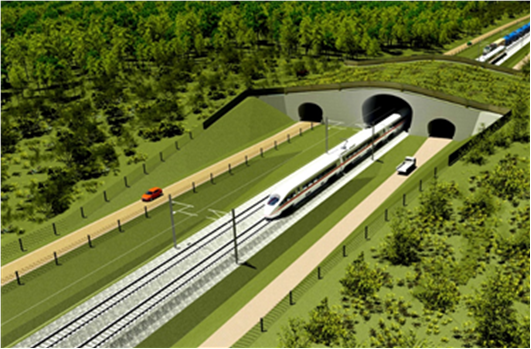
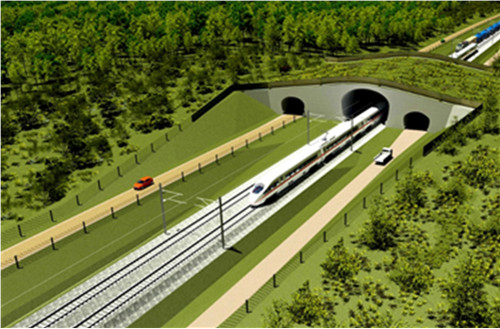
The ecoduct (wildlife crossing) of the Rail Baltica in the future.
The audit concluded that the acquisition of land in the Estonian section is five years behind the initial deadline and the Ministry of Economic Affairs and Communications does not have a complete overview of how many and which parcels of land have to be acquired for the construction of Rail Baltica. Delays are also evident in the design process. The plan serving as the basis for the preliminary design in Pärnu County (which will include approximately one quarter of the Estonian section of Rail Baltica) was partially repealed by the Supreme Court due to insufficient environmental impact assessment. The audit underlined that the initial aim to complete the railway by 2026 is unrealistic and the project’s schedule must be updated. The audit also highlighted that, despite significant changes in the cost estimates for some activities, the total cost estimate of the Estonian section of Rail Baltica was not renewed nor was the budget planned throughout until the completion of the project. Therefore, it was impossible to assess whether the total budget estimate was exceeded. The National Audit Office recommended the Minister to update the budget of Rail Baltica for the railway section in Estonia until the completion of construction.
For more information, please contact Mr. Silver Jakobson at silver.jakobson@riigikontroll.ee.
 Finland : Experiences in Developing Sustainable Mining Through Self-Regulation
Finland : Experiences in Developing Sustainable Mining Through Self-RegulationSerious gypsum waste basin leaks occurred in the Talvivaara mine in 2012 and 2013, as a result of which, acidic water containing metal and sulphate was released into the environment. For this reason, there were growing calls for more responsibility from mining companies. Social acceptability of the mining sector was also questioned. The discussion raised the idea that a mining company must gain the acceptance of the local community (social licence to operate).
As a result of the Talvivaara accident, the Finnish Government initiated an action plan on making Finland the leader in sustainable extractive industries in 2013. The action plan’s recommendations led to the establishment of the Sustainable Mining Network (the Network), which serves as a discussion and cooperation forum for the mining industry and stakeholders. The National Audit Office of Finland examined the Network’s operations in the report Perspectives on Sustainable Mining in Finland, published in May 2021.
The Network has worked well. It can serve as a channel of communication between actors, while creating peer pressure among the parties, encouraging them to develop their activities. The Network developed a self-regulatory mining responsibility system comprising a variety of different assessment tools. The Finnish system is based on the model used in Canada, Towards Sustainable Mining (TSM). The original Canadian TSM model has been tailored to Finnish conditions and legislation and equipped with evaluation tools for water management and mine closures. Finland was the first country in Europe to introduce such a system in 2016.
The first self-evaluations of the mining companies were published in autumn 2020. Based on the self-evaluations, water management is the area with the greatest room for improvement.
The mining responsibility system is a workable operating model, which can promote the sustainability of operations and harmonise the operating practices of mining companies. A mining company can also use the responsibility system as an internal management tool. However, there are also challenges in the use of the system. Assessing responsibility on the basis of the system is a complex process. In practice, the system is best suited for relatively large mining companies.
For more information, please see:
https://www.vtv.fi/en/publications/perspectives-on-sustainable-mining-in-finland/ and
https://www.vtv.fi/en/blog/what-does-a-social-licence-to-operate-mean-in-mining/.
Contact: Matti Vedenkannas, Principal Legislative Adviser, LL.D., matti.vedenkannas@vtv.fi.
 Finland : Published Performance Audit: “Finland’s International Climate Finance – Steering and Effectiveness”
Finland : Published Performance Audit: “Finland’s International Climate Finance – Steering and Effectiveness”Under the Paris Agreement, Finland, along with other industrialised countries, has committed to support developing countries’ efforts to mitigate and adapt to climate change. The Finnish government’s current policy is to scale up Finland's climate finance and allocate it equally to climate change mitigation and adaptation. Finland’s international climate finance is part of the official development assistance administered by the Ministry for Foreign Affairs of Finland (MFA).
The National Audit Office of Finland examined the preconditions provided by the management system of Finland's international climate finance for its effectiveness. The audit found that the MFA does not have a published plan regarding the objectives, amount, or distribution of the increasing climate finance. The administration of
climate finance has been decentralised to several units of the MFA without overall coordination. The MFA’s human resources for the steering of climate finance are partly meagre, which is a risk to the quality of the steering.
The recently updated “theories of change” and indicators of development policy, as well as the case management system of the MFA, provide a good basis for results-based management, collection of statistics and reporting on climate finance. However, the climate finance statistics and reporting are prone to errors. Moreover, the MFA produces and receives information on the results of climate finance to a variable degree from various funding instruments and organisations that channel funding. The information on the effectiveness of climate finance is partly inconsistent and inadequate, which makes it difficult to obtain a clear overview of its performance. The MFA has used the information on the results of climate finance relatively little in its decision-making, evaluations, reporting and communication.
The National Audit Office recommended that the MFA draw up a public plan for increasing and allocating Finland's international climate finance that justifies the related choices and priorities. The Ministry should also justify the climate finance decisions from the perspective of climate results and ensure that results are monitored, recorded and reported as systematically and as consistently as possible.
The full report is available at: https://www.vtv.fi/app/uploads/2021/09/NAOF-Audit-6-2021-Finlands-international-climate-finance.pdf.
A briefing paper on Finland’s international climate finance and gender equality is available at: https://www.vtv.fi/app/uploads/2021/09/naof-briefing-paper-the-objectives-of-climate-finance-include-empowering-women-and-girls.pdf.
For more information, please, contact Pekka Salminen at: pekka.salminen@vtv.fi.
 India : Violation of Emissions & Air Quality Standards by the State-Operated Bus Fleet in West Bengal
India : Violation of Emissions & Air Quality Standards by the State-Operated Bus Fleet in West BengalAir pollution is an issue of concern in India, according to the State of Environment Report (India, 2019). Air pollution and its resultant impacts can be attributed to emissions from vehicular, industrial, and domestic activities. Around 32 percent of West Bengal’s (a state in the eastern part of India) population lives in locations where the air quality is affected by emissions from industrial sources and road traffic. Five State Transport Undertakings (STUs), owned by the Government of West Bengal (GoWB), run bus services across the state and in the neighbouring states. SAI India studied the vehicular emissions of these five STUs, along with the compliance of their bus fleet with air quality norms.
SAI India found that out of 2,821 buses run by the five STUs, more than 99 percent ran on diesel, a polluting fuel. Overall, a reduction of emission of 19 million kgs CO2 could have taken place yearly, by the introduction of compressed natural gas (CNG) buses. However, no steps were planned for introducing CNG buses in the State despite availability of funds and despite the fact that CNG buses caused less pollution than diesel buses. In violation of Government of India/GoWB orders, as of 31 March 2017, 77 percent of buses operated by the five STUs did not meet the existing emission standards. Preventive maintenance to control pollution did not take place (91 percent shortfall) which led to incomplete combustion/ higher consumption of diesel with increased emission of smoke. Consequently, all the buses operated by the STUs emitted CO2 which was much higher than the norms contained in National Ambient Air Quality Standard. As a result, many cities in West Bengal suffered from hazards caused by emissions from the transport sector to which the STUs were the major contributors. The effective kilometres travelled per passenger per day by trams, a more environment friendly transport option, run on electricity, reduced by 20 percent during 2013-16 due to reduction in tram services by the GoWB. Thus, the government did not pay adequate attention to environment friendly transport options.
After this report was submitted to the GoWB, it introduced electric buses and planned the introduction of more such buses, including CNG buses.
 Latvia : Audit on Wild Game Monitoring
Latvia : Audit on Wild Game MonitoringThere was unexpectedly high interest in Latvia in the State Audit Office report “Is our game species management sustainable?” (2020). Everyone had a strong opinion about whether Eurasian lynx hunting should or should not be permitted.
The aim of the audit was to determine whether the proper prerequisites have been established for assessing the management of large carnivores (Eurasian lynx and grey wolf) and whether the legal framework of Eurasian lynx hunting and the approach established in Latvia in setting harvest quotas comply with the common European position. In addition, the State Audit Office evaluated the management of cloven-hoofed animals (elk, red deer, roe deer) and the State Forest Service’s (SFS) supervision of species management and observance of laws regulating hunting.
The findings of this audit lead us to conclude that, despite some measures taken in recent years to improve game management in Latvia, there is no responsible and sustainable game species management and no balance ensured among the different interests of hunters, foresters, farmers, and environmental protection.
Auditors concluded that the reliability and usability of SFS’s data on the condition of the large carnivore population is questionable. Furthermore, according to the government regulation determining the lynx species as a specially protected species of limited harvest (hunting), the SFS decides on its harvest limits without assessing the purposes and alternatives in accordance with the provisions of the Habitats Directive.
Regarding cloven-hoofed animals, the audit determined that their number is increasing every year. SFS also increases the hunting limits annually, which are higher than the economic growth of the species. Auditors found that forest owners and the users of hunting rights are often pushing for higher harvest quotas for cloven-hoofed animals.
While implementing recommendations provided in a previous audit covering the efficiency and structural reforms of the SFS, the SFS developed an internal regulation improving the procedure for performing controls and, in general, the number of accidents in hunting has decreased. At the same time, the number of senior hunting inspectors who are directly responsible for hunting supervision is still insufficient, among other things.
The audit report summary is available at: https://www.lrvk.gov.lv/en/audit-summaries/audit-summaries/is-our-game-management-sustainable. For more information, please contact Uldis.Kalnins@lrvk.gov.lv.
 Russian Federation : Automated Systems for Processing Audit Information
Russian Federation : Automated Systems for Processing Audit InformationThe Accounts Chamber of the Russian Federation (SAI Russia) pays special attention to environmental auditing. Every year, audits on most topical issues in this area are carried out using effective methodological approaches. SAI Russia integrates digital solutions and products to automate data collection and analysis for more accurate and reliable audit results.
SAI Russia actively involves experts in its activities, which increases the reliability and validity of audits. Notably, the involvement of a wide range of consultants in environmental protection auditing and ecological safety in the Arctic zone of the Russian Federation has led to the introduction of automated systems for processing large volumes of audit information. This includes tools for analyzing open source data and data from state information systems, using factor analysis and statistical modeling for risk assessment, as well as PolyAnalyst, Python, and R tools.
A project-based approach has been used by SAI Russia to carry out a set of audit and analytical activities to help identify problems and shortcomings influencing forest management performance. This approach allows SAI Russia to evaluate the efficiency of forest management, including measures to prevent illegal logging, and develop proposals for improving policy in this area and introducing them into the work of the relevant authorities. It has also facilitated the implementation of SAI Russia recommendations by the federal and regional executive authorities. In particular, it helped launch the work on creating a unified automated information system for forest management in Russia. It aims to systemize information on the stages of work in forestry, from the procurement and planting of forestry seeds, to the harvesting and sale of timber.
 United States : New Snapshot Product Lines
United States : New Snapshot Product Lines The U.S. Government Accountability Office (GAO) has added “Snapshot” product lines that help synthesize GAO’s past work on current issues in a brief, educational format. They are 2 to 3 pages long, with the longer length for “crosscutting” Snapshots that cover broader topics.
The Snapshot product lines are based on published GAO reports, with updated facts, figures, or references to current events, as appropriate. They are designed to showcase important findings and open recommendations, and they emphasize the use of graphics to clearly convey information.
GAO issued a prototype on September 20, 2021, that discusses GAO’s reports on electricity grid resilience. The first official Snapshot, which discusses hardrock mining, was issued on November 16, 2021. GAO used this Snapshot to link concepts and principles from previously issued reports and was able to provide Congressional members with a roadmap for hardrock mining reform—which is being actively debated in Congress.
GAO believes these new Snapshot products will help keep GAO at the forefront of government accountability by ensuring that Congressional members and the public get the information they need in a timely manner. They can be used to summarize multiple GAO reports on a topic or highlight important considerations for emerging issues. In addition, the products will also allow GAO to highlight broader messages that may not be as readily apparent or impactful within the context of any one report.
The Snapshots are available at https://www.gao.gov/assets/gao-21-105403.pdf and https://www.gao.gov/assets/gao-22-105438.pdf. For further information, contact Alfredo Gomez at gomezj@gao.gov.

The INTOSAI Working Group on Environmental Auditing (WGEA) aims to increase the expertise in environmental auditing and to enhance environmental governance with high-quality contribution and visibility by both members of the Working Group and non–member SAIs. Currently the INTOSAI WGEA consists of 86 member countries.
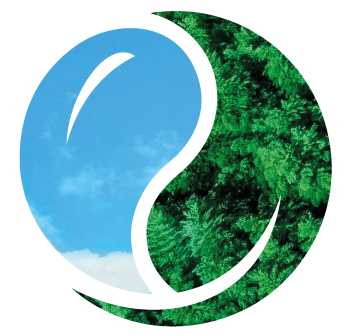
Vivi Niemenmaa - Secretary General
Email: vivi.niemenmaa@vtv.fi
Nella Virkola - International Affairs Planner
Email: nella.virkola@vtv.fi
Raisa Ojala - Deputy Secretary General
Email: raisa.ojala@vtv.fi
India Roland - International Affairs Planner (on leave)
Email: india.roland@vtv.fi
Kati Hirvonen - Project Specialist (on leave)
Email: kati.hirvonen@vtv.fi
Emilia Linnekoski - Intern
Email: emilia.linnekoski@vtv.fi
Sari Suonpää - Intern
Email: sari.suonpaa@vtv.fi
Mohamed Ibrahim Jaleel - Environmental Audit Manager
Email: mohamed.jaleel@audit.gov.mv
We collect and process your data on this site to better understand how it is used. We always ask you for consent to do that. You can change your privacy settings here.